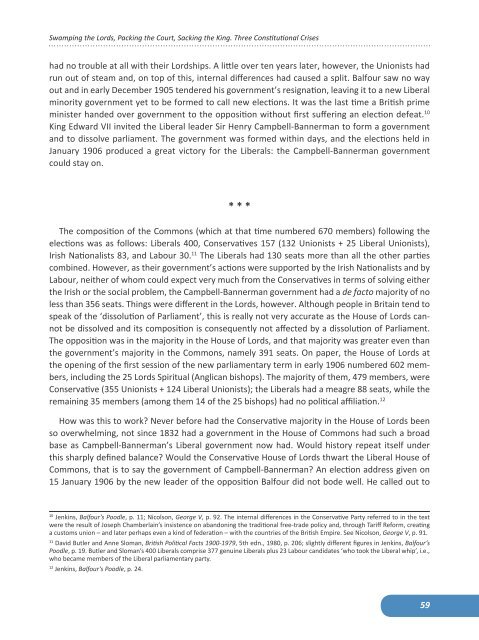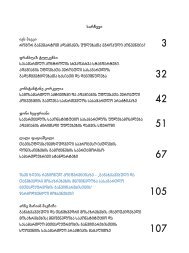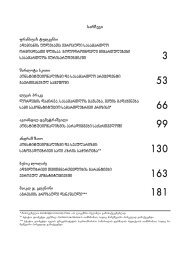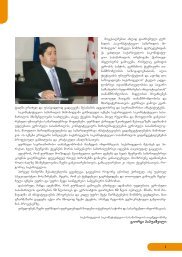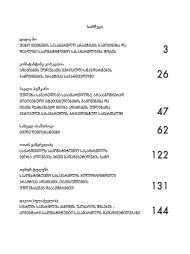Contents - Constitutional Court of Georgia
Contents - Constitutional Court of Georgia
Contents - Constitutional Court of Georgia
Create successful ePaper yourself
Turn your PDF publications into a flip-book with our unique Google optimized e-Paper software.
Swamping the Lords, Packing the <strong>Court</strong>, Sacking the King. Three <strong>Constitutional</strong> Crises<br />
had no trouble at all with their Lordships. A little over ten years later, however, the Unionists had<br />
run out <strong>of</strong> steam and, on top <strong>of</strong> this, internal differences had caused a split. Balfour saw no way<br />
out and in early December 1905 tendered his government’s resignation, leaving it to a new Liberal<br />
minority government yet to be formed to call new elections. It was the last time a British prime<br />
minister handed over government to the opposition without first suffering an election defeat. 10<br />
King Edward VII invited the Liberal leader Sir Henry Campbell-Bannerman to form a government<br />
and to dissolve parliament. The government was formed within days, and the elections held in<br />
January 1906 produced a great victory for the Liberals: the Campbell-Bannerman government<br />
could stay on.<br />
* * *<br />
The composition <strong>of</strong> the Commons (which at that time numbered 670 members) following the<br />
elections was as follows: Liberals 400, Conservatives 157 (132 Unionists + 25 Liberal Unionists),<br />
Irish Nationalists 83, and Labour 30. 11 The Liberals had 130 seats more than all the other parties<br />
combined. However, as their government’s actions were supported by the Irish Nationalists and by<br />
Labour, neither <strong>of</strong> whom could expect very much from the Conservatives in terms <strong>of</strong> solving either<br />
the Irish or the social problem, the Campbell-Bannerman government had a de facto majority <strong>of</strong> no<br />
less than 356 seats. Things were different in the Lords, however. Although people in Britain tend to<br />
speak <strong>of</strong> the ‘dissolution <strong>of</strong> Parliament’, this is really not very accurate as the House <strong>of</strong> Lords cannot<br />
be dissolved and its composition is consequently not affected by a dissolution <strong>of</strong> Parliament.<br />
The opposition was in the majority in the House <strong>of</strong> Lords, and that majority was greater even than<br />
the government’s majority in the Commons, namely 391 seats. On paper, the House <strong>of</strong> Lords at<br />
the opening <strong>of</strong> the first session <strong>of</strong> the new parliamentary term in early 1906 numbered 602 members,<br />
including the 25 Lords Spiritual (Anglican bishops). The majority <strong>of</strong> them, 479 members, were<br />
Conservative (355 Unionists + 124 Liberal Unionists); the Liberals had a meagre 88 seats, while the<br />
remaining 35 members (among them 14 <strong>of</strong> the 25 bishops) had no political affiliation. 12<br />
How was this to work? Never before had the Conservative majority in the House <strong>of</strong> Lords been<br />
so overwhelming, not since 1832 had a government in the House <strong>of</strong> Commons had such a broad<br />
base as Campbell-Bannerman’s Liberal government now had. Would history repeat itself under<br />
this sharply defined balance? Would the Conservative House <strong>of</strong> Lords thwart the Liberal House <strong>of</strong><br />
Commons, that is to say the government <strong>of</strong> Campbell-Bannerman? An election address given on<br />
15 January 1906 by the new leader <strong>of</strong> the opposition Balfour did not bode well. He called out to<br />
10 Jenkins, Balfour’s Poodle, p. 11; Nicolson, George V, p. 92. The internal differences in the Conservative Party referred to in the text<br />
were the result <strong>of</strong> Joseph Chamberlain’s insistence on abandoning the traditional free-trade policy and, through Tariff Reform, creating<br />
a customs union – and later perhaps even a kind <strong>of</strong> federation – with the countries <strong>of</strong> the British Empire. See Nicolson, George V, p. 91.<br />
11 David Butler and Anne Sloman, British Political Facts 1900-1979, 5th edn., 1980, p. 206; slightly different figures in Jenkins, Balfour’s<br />
Poodle, p. 19. Butler and Sloman’s 400 Liberals comprise 377 genuine Liberals plus 23 Labour candidates ‘who took the Liberal whip’, i.e.,<br />
who became members <strong>of</strong> the Liberal parliamentary party.<br />
12 Jenkins, Balfour’s Poodle, p. 24.<br />
59


